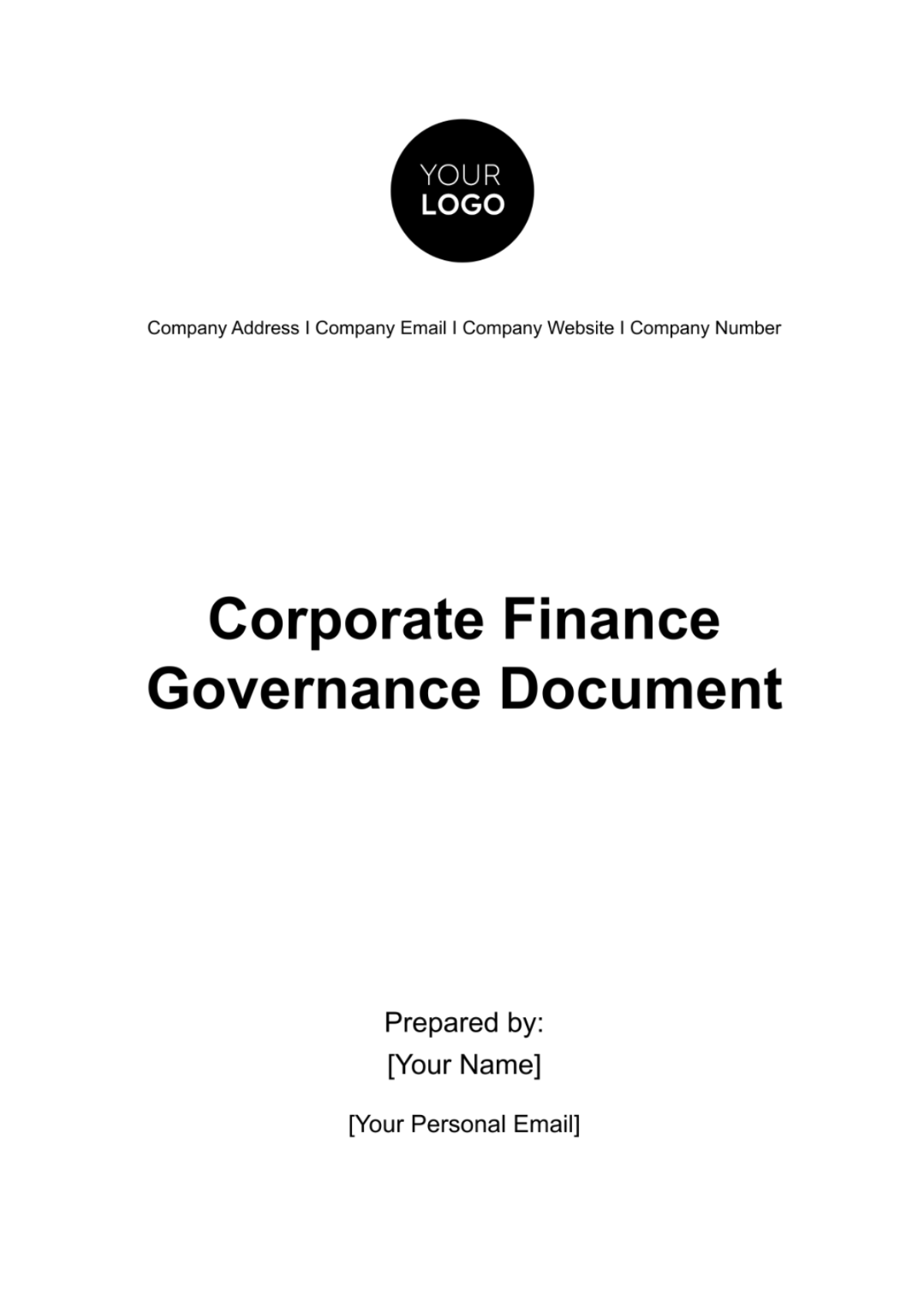Free Corporate Finance Governance Document

Introduction to Financial Governance
This document establishes a comprehensive framework for financial governance within [Your Company Name]. It is designed to ensure that all financial activities are conducted with the utmost integrity, transparency, and in full compliance with legal and regulatory standards. This framework is pivotal in supporting the company’s strategic objectives while safeguarding its financial health and stakeholder interests.
Purpose of the Document
The primary objective of this document is to provide clear and robust guidelines for financial management within the company. It serves as a reference for all financial decisions and activities, aiming to enhance financial discipline, ensure regulatory compliance, and promote ethical financial practices across all departments and subsidiaries.
Scope and Applicability
This financial governance policy is applicable to all financial transactions, reporting, and planning activities within the company. It is mandatory for all employees, management, and board members involved in financial decision-making or handling financial information. The policy covers various aspects of financial management, including budgeting, reporting, auditing, risk management, and ethical conduct.
Financial Management Principles
The financial management of [Your Company Name] is governed by a set of core principles that ensure the company's financial resources are managed effectively, responsibly, and ethically.
Prudence and Accountability
We adhere to a principle of prudence in managing the company’s finances. This involves a cautious and judicious approach to financial planning, investment, and expenditure. Accountability is integral to our financial processes, ensuring that all financial decisions and transactions are transparent, traceable, and aligned with the company’s objectives.
(Table: Financial Accountability Matrix)
Activity | Responsible Party | Oversight Body |
Budget Approval | Chief Financial Officer | Board of Directors |
Expenditure Authorization | Department Heads | Finance Department |
Financial Reporting | Finance Department | Internal Audit Committee |
Risk Management
Effective financial risk management is vital for the stability and success of the company. Our approach includes the identification, assessment, and mitigation of financial risks. We regularly review potential risks, such as market volatility, credit risks, and liquidity challenges, and implement strategies to manage these risks proactively.
(Table: Risk Management Framework)
Risk Type | Identification Method | Mitigation Strategy |
Market Risk | Financial Market Analysis | Hedging, Diversification |
Credit Risk | Credit Scoring | Credit Limits, Monitoring |
Operational Risk | Process Audits | Internal Controls, Training |
Financial Planning and Budgeting
Effective financial planning and budgeting are crucial for the strategic and operational success of [Your Company Name]. This section outlines our approach to creating, managing, and reviewing the company's financial plans and budgets.
Annual Budget Preparation
The annual budgeting process is a critical activity that aligns the company's financial resources with its strategic objectives. This process begins with a review of the previous year's performance and an assessment of future opportunities and risks. Departmental heads are responsible for submitting their budget proposals, which are then consolidated by the finance team.
(Table: Annual Budget Timeline)
Month | Activity |
January | Review of previous year's performance |
February | Initial budget proposals from departments |
March-April | Consolidation and review by finance team |
May | Presentation to senior management |
June | Final adjustments and board approval |
Long-term Financial Planning
Our long-term financial planning focuses on sustaining financial health and supporting the company’s growth over a 5-10 year horizon. This includes investment strategies, capital expenditure planning, and revenue forecasting. The goal is to balance short-term achievements with long-term objectives, ensuring financial sustainability and value creation for stakeholders.
(Table: Five-Year Financial Projection)
Year | Revenue Forecast | Capital Expenditure | Expected Profit |
Year 1 | $100M | $20M | $15M |
Year 2 | $120M | $25M | $20M |
Year 3 | $140M | $30M | $25M |
Year 4 | $160M | $35M | $30M |
Year 5 | $180M | $40M | $35M |
Financial Reporting and Compliance
Accurate and timely financial reporting, coupled with strict adherence to compliance standards, is fundamental to our operations. This section details the standards and practices for financial reporting and regulatory compliance.
Internal Financial Reporting Standards
Our internal financial reporting standards ensure that financial information is accurate, complete, and provided in a timely manner. Monthly, quarterly, and annual reports are prepared, offering insights into the company's financial health, highlighting key performance indicators, and identifying areas requiring attention.
(Table: Internal Reporting Schedule)
Report Type | Frequency | Content Overview |
Monthly | Monthly | Income Statement, Cash Flow |
Quarterly | Quarterly | Balance Sheet, Departmental Reports |
Annual | Yearly | Comprehensive Financial Analysis |
External Financial Reporting and Compliance
We are committed to full compliance with external financial reporting standards and regulatory requirements. This includes adhering to generally accepted accounting principles (GAAP) and international financial reporting standards (IFRS), as well as complying with tax laws and regulations.
Requirement | Compliance Method |
GAAP adherence | Regular Audits, Staff Training |
IFRS compliance | Reporting Standards Review |
Tax Regulations | Quarterly Tax Audits, Legal Reviews |
Internal Controls and Audit
A robust system of internal controls and regular audits are essential to maintain the integrity of [Your Company Name]'s financial processes and reports. This section outlines our approach to ensuring accuracy and reliability in financial reporting and operations.
Internal Control Systems
Our internal control systems are designed to prevent and detect errors, fraud, and mismanagement of funds. These controls span various levels of the organization and include checks and balances, segregation of duties, authorization protocols, and regular reconciliations.
(Table: Key Internal Controls)
Control Area | Control Mechanism |
Transaction Authorization | Limits based on role and hierarchy |
Financial Reconciliation | Monthly cross-department checks |
Access Controls | Restricted access to financial systems |
Internal and External Audit Processes
The audit processes, both internal and external, play a critical role in maintaining financial integrity and transparency. Internal audits are conducted regularly to assess the effectiveness of internal controls, compliance with policies, and to identify areas for improvement. External audits are performed annually by an independent auditor, providing an objective assessment of our financial statements and practices.
(Table: Audit Schedule)
Audit Type | Frequency | Scope |
Internal | Quarterly | Operational, Compliance |
External | Annually | Financial Statements |
Investment and Capital Management
Sound investment and capital management strategies are crucial for the financial growth and sustainability of [Your Company Name]. This section outlines our policies and procedures for managing investments and capital expenditures.
Investment Policies
Our investment policy is centered around balancing risk and return, diversifying our investment portfolio, and aligning investments with the company's long-term strategic goals. Investment decisions are made based on thorough market analysis and projected returns, under the oversight of the Investment Committee.
(Table: Investment Strategy Overview)
Investment Type | Strategy | Expected Return |
Equities | Diversified portfolio | 8-12% annually |
Bonds | Mix of government and corporate | 4-6% annually |
Real Estate | Long-term property investments | 6-10% annually |
Capital Expenditure Management
Capital expenditure (CapEx) management is a critical aspect of our financial strategy. It involves careful planning, analysis, and approval of expenditures on assets that will yield benefits over a long period. The CapEx process ensures that such investments are aligned with our strategic objectives and have undergone rigorous cost-benefit analysis.
(Table: Capital Expenditure Approval Process)
Expenditure Range | Approval Authority |
Up to $100,000 | Department Heads |
$100,000 - $500,000 | Chief Financial Officer |
Above $500,000 | Board of Directors |
Ethics and Financial Conduct
Maintaining the highest standards of ethics and conduct in financial matters is a cornerstone of [Your Company Name]'s corporate integrity. This section outlines our commitment to ethical practices in all financial activities.
Code of Ethics in Finance
Our financial code of ethics is a set of principles that govern the conduct of our financial professionals. It emphasizes honesty, integrity, and transparency in financial reporting and decision-making. All employees involved in financial management are required to adhere to this code, which includes principles such as fair representation of financial status, avoidance of conflicts of interest, and confidentiality of financial information.
(Table: Key Principles of Financial Ethics)
Principle | Description |
Transparency | Open and accurate reporting of financial data |
Integrity | Honest and ethical handling of financial transactions |
Accountability | Responsibility for financial decisions and their impact |
Conflict of Interest Policy
Our conflict of interest policy is designed to identify and manage situations where an employee's personal interests could conflict with the interests of the company. Employees are required to disclose any potential conflicts of interest, which are then evaluated and managed to prevent any undue influence on financial decisions.
(Table: Conflict of Interest Management)
Situation | Disclosure Requirement | Management Action |
Financial Interest in Vendor | Immediate Disclosure | Removal from Decision Process |
Family Relationships with Clients | Disclosure at Hiring | Monitoring and Regular Review |
Training and Development
To ensure the highest level of competence in managing the company's finances, [Your Company Name] invests in the continuous training and development of its financial staff.
Ongoing Professional Development
We offer a range of professional development opportunities for our finance staff, including workshops, seminars, and courses on the latest financial management practices and tools. This ongoing training ensures our team remains at the forefront of industry standards and best practices.
(Table: Professional Development Programs)
Program Type | Frequency | Description |
Workshops | Quarterly | Hands-on sessions on financial tools and software |
Seminars | Biannually | Updates on financial regulations and trends |
Certification Courses | Annually | Advanced training in specialized financial areas |
Training on Financial Policies and Procedures
Regular training sessions are conducted to ensure all employees understand and can effectively implement our financial policies and procedures. These sessions are tailored to different departments and roles, ensuring that relevant financial practices are understood and applied consistently across the organization.
(Table: Financial Policy Training Schedule)
Department | Training Frequency | Training Content |
Finance | Quarterly | Advanced financial reporting, audit procedures |
Sales | Biannually | Budget management, expense reporting |
All Departments | Annually | Overview of financial policies, ethics |
- 100% Customizable, free editor
- Access 1 Million+ Templates, photo’s & graphics
- Download or share as a template
- Click and replace photos, graphics, text, backgrounds
- Resize, crop, AI write & more
- Access advanced editor
Establish robust finance governance with the Corporate Finance Governance Document Template from Template.net. This editable, customizable document lays out governance structures and policies in corporate finance. Essential for ensuring compliance, transparency, and ethical financial practices, it defines roles, responsibilities, and procedures, fostering a strong governance framework in financial management.





























